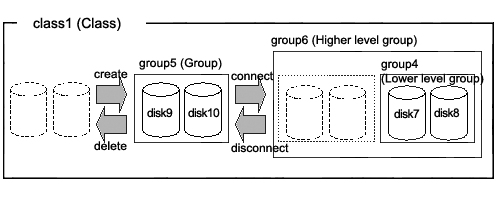Disk group acts as container for disks that will be mirrored, striped, concatenated or switched. They may be simply referred to as "groups."
Among group attributes is a type attribute. Type attribute values may be "mirror", "stripe", "concat" or "switch". By connecting multiple disks to a group, the disks within that group can be mirrored, striped, concatenated or switched one another, depending on the group's type attribute value.
You can also create a hierarchy of groups by connecting a group to another group. A group belonging to another group is called a lower level group, and a group above that group is called a higher level group.
A group belonging to another group will retain its own function specified by type attribute, while also acting as a disk belonging to that group. For example, when more than one "stripe" type group is connected to a "mirror" type group, the connected "stripe" type groups will be mirrored to each other. So the disks belonging to the "stripe" type group will be striped and mirrored.
Attributes
A group has the following attribute.
This attribute identifies the group within a class.
This attribute specifies the type of group. You can set to one of the following.
Disks and lower level groups belonging to the same group will be mirrored to each other. A maximum of 8 disks and lower level groups can be connected to a group collectively. In other words, a maximum of eight-way multiplex mirroring is supported.
Disks and lower level groups connected to the same group will each configure a stripe column, and will be striped. Since a maximum of 64 columns can be connected, you can stripe across a maximum of 64 columns.
Disks connected to a concatenation group will be concatenated. Since a maximum of 64 disks can be connected, a maximum of 64 disks can be concatenated.
The group consists of one active disk and one or less inactive disk. If an inactive disk is connected, the roles of the active and inactive disks can be switched.
This is an attribute of "stripe" type group, which indicates the data unit size when data is striped. The size you can set is (a value of two raised to the power) x 512 bytes and it meets the following conditions:
Minimum value: 512 bytes
Maximum value: the minimum value among the following
(A value of two raised to the 30th power) x 512 bytes (= 512 GB)
Available size of the smallest disk in a group
Available size of the smallest lower group in a group
This attribute indicates the active disk between disks that are connected to the switch type group.
Operation
The following operations are available for groups.
Indicating a new (higher level) group when connecting a disk with the sdxdisk -C command, or connecting a group with sdxgroup -C command will automatically create a (higher level) group.
For details on GDS Management View, see "5.2.3.3 Group Configuration."
Disconnecting the only remaining disk with the sdxdisk -D command, or disconnecting the only remaining lower level group with the sdxgroup -D command will automatically remove the (higher level) group. You can also delete a group using the sdxgroup -R command.
For details on GDS Management View, see "5.5.2 Removing a Group."
You can add a group to another group with the sdxgroup -C command. A group that is connected to another group is called a lower level group, and a group to which the group is added is called a higher level group.
For details on GDS Management View, see "5.4.2 Group Configuration."
The sdxgroup -D command disconnects the lower level group from the higher level group.
For details on GDS Management View, see "5.4.2 Group Configuration."
Group status can be displayed with the sdxinfo command.
For details on GDS Management View, see "5.3.1 Viewing Configurations/Statuses and Monitoring Statuses."
Group attribute values can be changed with the sdxattr -G command.
For details on GDS Management View, see "5.4.2 Group Configuration."
Reference
There are the following points of concern for groups.
Figure 2.4 Disk Group
